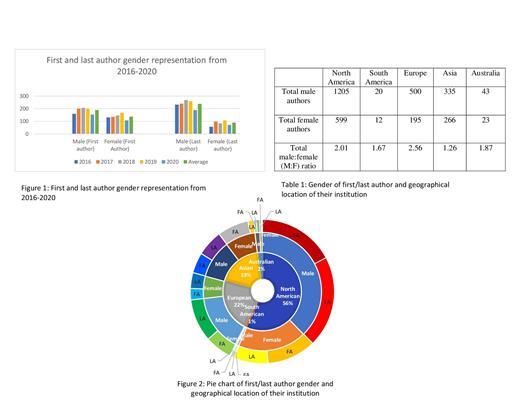Abstract
Introduction: Although gender disparities are continually improving within the medical field, these issues persist in academia and are evident in research authorship. The purpose of this study was to monitor the trend of such phenomena at the American Society of Hematology (ASH) Annual Meeting from 2016-2020.
Methods:We extracted data from acute myeloid leukemia (AML) poster presentations that were presented at the American Society of Hematology (ASH) Annual Meeting from 2016-2020. All poster presentations (n=1599) that fell under the "Acute myeloid leukemia: Clinical studies","Acute myeloid leukemia: Commercially available therapy, excluding transplantation", "Acute myeloid leukemia: Novel therapy excluding transplantation" and "Acute myeloid leukemia: Biology, cytogenetic and molecular markers in diagnosis and prognosis" subgroups were included in the study. There was a particular focus on the number of authors per poster presentation, gender of the first author, gender of the last author and geographical location of the first and last authors. The Google search engine was used to access to authors' biographical data and confirm their gender. T-tests and chi-square tests were used to better understand the gender differences.
Results:The average number of authors per poster presentation was 12.5. Of the 1599 posters reviewed, men represented the majority of all first authors (917/1599 (57%) vs 682/1599 (43%); p=0.014) (Figure 1). Men were more likely to be final authors compared to women (1186/1599 (74%) vs 413/1599 (26%); p<0.001) (Figure 1). Men experienced the highest rise in first authorship between 2016-2017 (+26%), whereas it was between 2018-2019 (+14%) for women. For last authors, the most significant rises were between 2017-2018 (+12%) for men and 2016-2017 (+68%) for women. Bother genders experienced the greatest decrease in first authorship between 2019-2020 (men (-23%) vs women (-36%)). A similar phenomenon was also observed for last authors between 2019-2020 (men (-27%) vs women (-34%)). There was also a significant relation between the gender of the authors and the geographical location of their institution (χ2= 39.6162; p<0.001) (Table 1 & Figure 2).
Conclusion:The number of women as first and last authors has steadily been increasing over the course of the past several years. Nevertheless, women continue to represent less than 50% of all first and last authors. This gender inequality was observed across all continents. Women were also less likely to be senior authors. It is important to continue to promote gender diversity in the field of medicine as it allows for different perspectives, greater collaboration and an increase in the talent pool.
Anwer: Janssen pharmaceutical: Honoraria, Research Funding; Allogene Therapeutics: Research Funding; BMS / Celgene: Honoraria, Research Funding; GlaxoSmithKline: Research Funding.


This feature is available to Subscribers Only
Sign In or Create an Account Close Modal